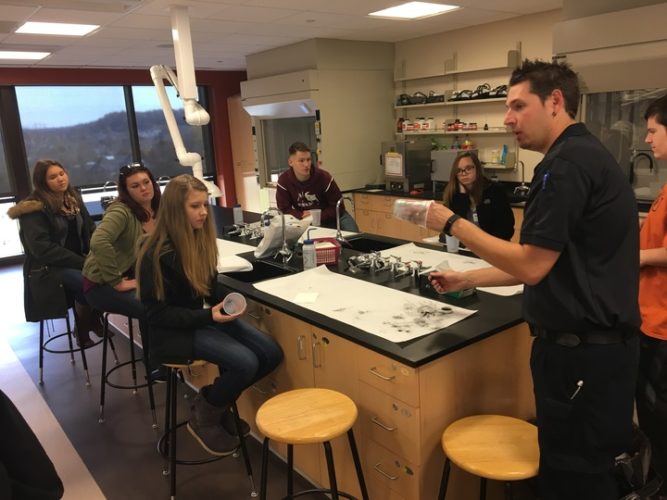 Edward Boice - The Yellow Jacket
Edward Boice - The Yellow Jacket High school students visited Waynesburg University Nov.11 to participate in the fall semester Mock Crime Scene event. The event has been a long time recruiting and educational event organized by the Forensic Science, Criminal Justice and Admissions departments.
The event consisted of four workshops discussing fingerprinting, blood analysis and other topics. These workshops aid students when they attempt to solve the mock crime scene. Michael Cipoletti, director of the Forensic Science Program, said the different skills taught in the workshops will not only be used at the mock crime scene, but also during students’ time here at Waynesburg, if they decide to attend.
“We try to incorporate different aspects of what they might be doing in their course work for both programs,” said Cipoletti.
The crime scene scenario this year involved a “disgruntled student stabbing her professor.” The high school students had to use the skills they learned in the four workshops to determine which of the three “suspects” committed the murder. While the process sounds straightforward, the journey to arrive at accusations goes differently than what most would think. Andrew Montini, senior interdisciplinary studies major, pointed out that media has warped the concept of the forensic scientist.
“Nowadays, people look on TV and see these shows and see in some cases a forensic scientist would collect evidence, go back to the lab, analyze it, get a result immediately and then go out and arrest the suspect,” said Montini. “In reality, it is not like that at all. A forensic scientist stays in the lab and analyzes the evidence that’s collected.”
Every year, the Criminal Justice and Forensic Science departments rotate in leading the event. The fall Mock Crime Scene was run by the Forensic Science Department. In the spring, it will be run by the Criminal Justice Department. Ultimately, the bonds these departments have formed gives a versatile presence in the event. Michael Cipoletti said the bonding of the two departments enables students to see which field of work they want to pursue.
“We have a lot of students that are interested in forensics and criminal justice,” Cipoletti said, “but are not really sure which is the appropriate fit for them, so what we try to do is give them some insight as to what both programs are like.”
Regardless of which department leads the event, Waynesburg’s students from both departments are always helping out. Whether it was enacting a dead body or helping in a workshop, students showed the participants what they have learned while here at Waynesburg. Montini himself found this event helpful when it came to making sure he knew his vocation.
“It helps me in a way. It keeps me on my toes. If a student asks about what to do, I can say ‘hey have you thought about doing this,’” said Montini. “It allows us to show what we have learned over the years.”
While the event is to teach high school students how to run a crime scene, the teenagers were not the only ones who were learning. A fingerprint collection workshop for parents was provided so they could get a taste of what their children learned. Faith Musko, instructor of chemistry and forensic science, said the parent workshop can tie together the experience of the entire family.
“While a student was learning about fingerprinting, the parents could also learn about fingerprinting,” said Musko. “This allows the parents to talk with their child about the subject and have an educated conversation about what they both learned, instead of the parents asking questions, trying to figure out what their child learned.
